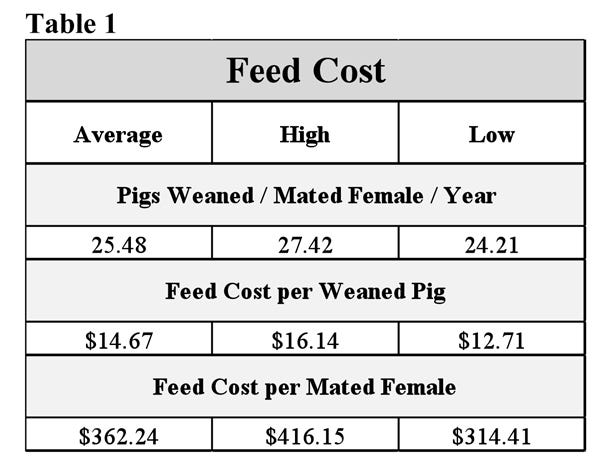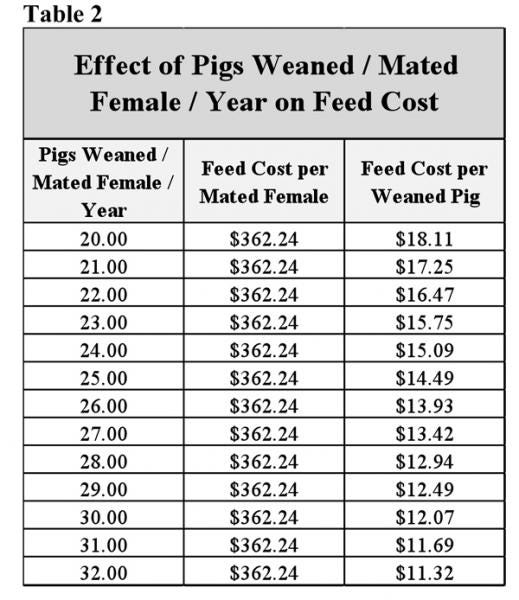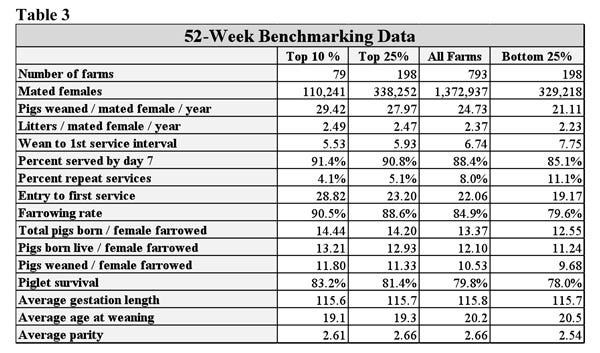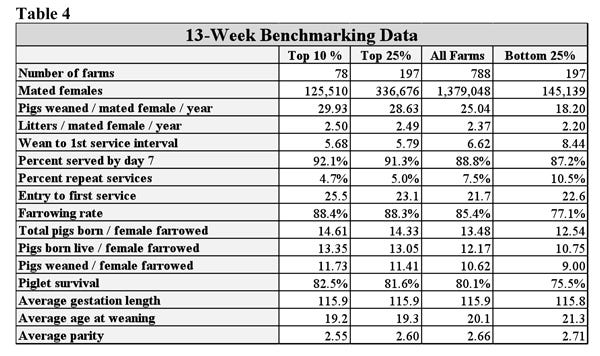Getting a Handle on High Feed Costs
As feed costs continue to climb, we are working with farm managers to adjust management and fine-tune standard operating procedures (SOPs) to maximize the number of pigs being weaned/mated female/year (PW/MF/Y).
September 7, 2012

As feed costs continue to climb, we are working with farm managers to adjust management and fine-tune standard operating procedures (SOPs) to maximize the number of pigs being weaned/mated female/year (PW/MF/Y).
Breed-to-wean sow farms – These farms have a goal to produce the maximum number of acceptable pigs, according to a weaned-pig contract and grading schedule, to lower the feed cost/weaned pig. These farms usually try to maximum the number of breeding females on the farm and they generally try to wean pigs at less than 20 days of age weighing at least 12 lb. No pigs are sold below the contract minimum weight. Some of these farms are starting to see some weaned-pig contracts broken or buyers asking for a reduced price on weaned pigs.
Breed-to-finish farms – These farms have different goals. They try to wean the correct number of pigs each week to flow to grow out facilities, optimize available pig spaces, and market the highest percentage of full-value pigs as possible.
Breed-to-finish farm female inventory is based on the number of pigs needed weekly and their current level of production. As PW/MF/Y increases, the female inventory can be reduced, thus lowering their total feed cost. With fewer females on the farm, some gestation spaces will sit empty. But fewer females will also allow some of the farm’s workforce to be shifted to other key areas of the farm, such as spending more time in breeding, working on sow body condition, or taking better care of the pigs in farrowing.
In breed-to-finish farms, weaning age is 20 days of age or higher at weights of 13 lb. or more. Weaning older, heavier pigs reduces the pounds of the higher-priced nursery diets fed. And, adding a pound to weaned-pig weights should mean those pigs will go to market seven to 10 days sooner.
To improve the percentage of full value pigs marketed, the number of substandard pigs from the sow farm needs to be reduced. Many of these farms are now trying to determine the minimum birth weight at which a full value pigs can be produced in their system. As total born increases, some farms set the minimum weight at 2 lb.; pigs below this birth weight are euthanized.
It is important to spend time walking pens, looking for sick and fall-behind pigs to treat, euthanizing non-responsive pigs when necessary or selling slow-growing pigs to the roaster market. These steps will help avoid putting high priced feed in pigs that will not make full value.
The goal for both types of farms is to produce the maximum number of quality weaned pigs or full value market hogs per mated female per year for the maximum number of dollars.
Feed Cost Tracking
The financial database in our Swine Management Services (SMS) database allows us to track feed cost/weaned pig and feed cost/mated female.
Feed cost/weaned pig is affected dramatically by PW/MF/Y. Feed cost/mated female is not affected by PW/MF/Y and provides a better comparison between farms because it measures the feeding efficiency of the farm and diet cost. Ration cost should be analyzed by your nutritionist.
If you are thinking about using some alternative feed ingredients this year, be careful to consider how the changes will affect the daily feeding rates in gestation to maintain female body condition and how it will affect milk production in lactation and subsequent weaned pig weight and quality. Some alternative ingredients may look like a cost saving, but it is important to do the math and an analysis before a change is made.
Table 1 provides a feed cost summary of eight farms from the SMS financial database. We look at a 12-month rolling average for feed costs, including all diet ingredients, additives, medications, feed preparation and feed delivery.
The average feed cost/mated female was $362.24. The farm with the lowest feed cost/mated female is $314.41. This farm booked corn and soybean meal in the fall of 2011 for 12 months. The farm with the highest feed cost/mated females came in at $416.15. The average feed cost/weaned pig is $14.67, with a low of $12.71 and high of $16.14.

Table 2 shows the effect that PW/MF/Y has on feed costusing an average feed cost/mated female of $362.24. Dividing this average cost by PW/MF/Y, we see a range from $18.11/weaned pig at 20 PW/MF/Y to $11.32 PW/MF/Y when 32 PW/MF/Y.
If your feed cost per mated female is at the high end ($416.15) and you are weaning at the low end – 20 PW/MF/Y the cost per weaned pig is $20.81. Even with that high feed cost, 32 PW/MF/Y would bring the cost per weaned pig down to $13.00.
Do you know your feed costs per weaned pig or per mated female? With feed costs trending higher, you need to work closely with your nutritionist to formulate a plan to keep feed costs low without affecting sow body condition and production. On many farms, this starts with a plan to improve the percent of quality weaned pigs or the percent of full value pigs, if you are farrow-to-finish.

Past Columns Posted at www.nationalhogfarmer.com
Previous “Production Preview” columns can be found at www.nationalhogfarmer.com. Click on “newsletters,” then the respective date of the Weekly Preview issue you are interested in.
Key Performance Indicators
Tables 3 and 4 (below) provide 52-week and 13-week rolling averages for key performance indicators (KPI) of breeding herd performance. These tables reflect the most current quarterly data available and are presented with each column. The KPI’s can be used as general guidelines to measure the productivity of your herd compared to the top 10% and top 25% of farms, the average performance for all farms, and the bottom 25% of farms in the SMS database.


If you have questions or comments about these columns, or if you have a specific performance measurement that you would like to see benchmarked in our database, please address them to: [email protected] or [email protected].
You May Also Like



